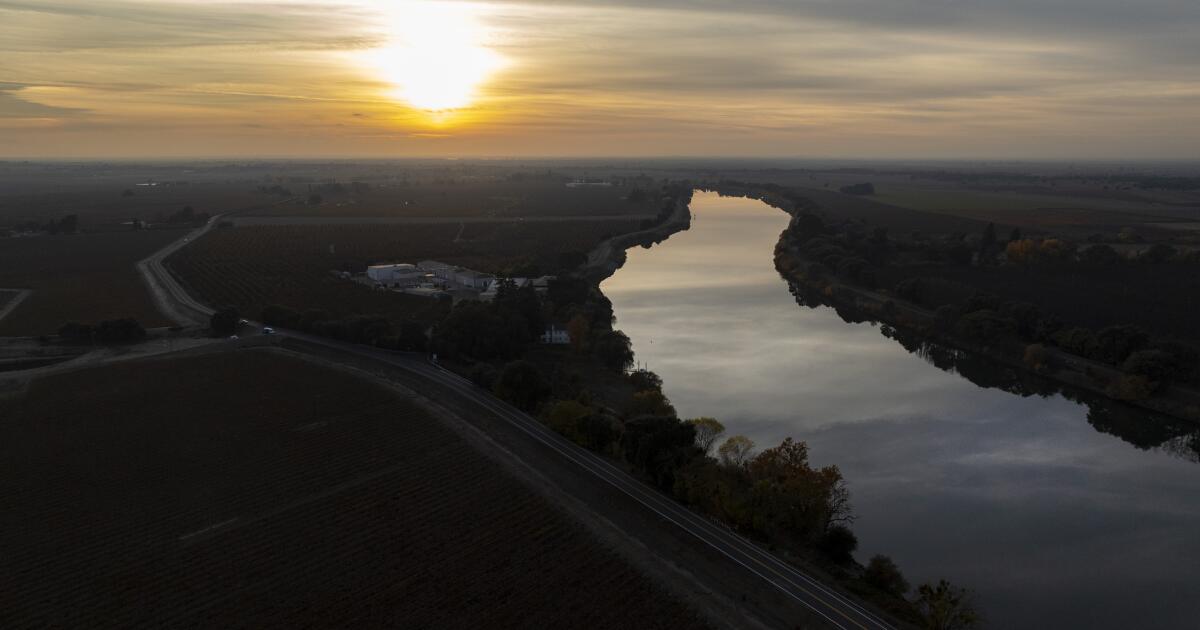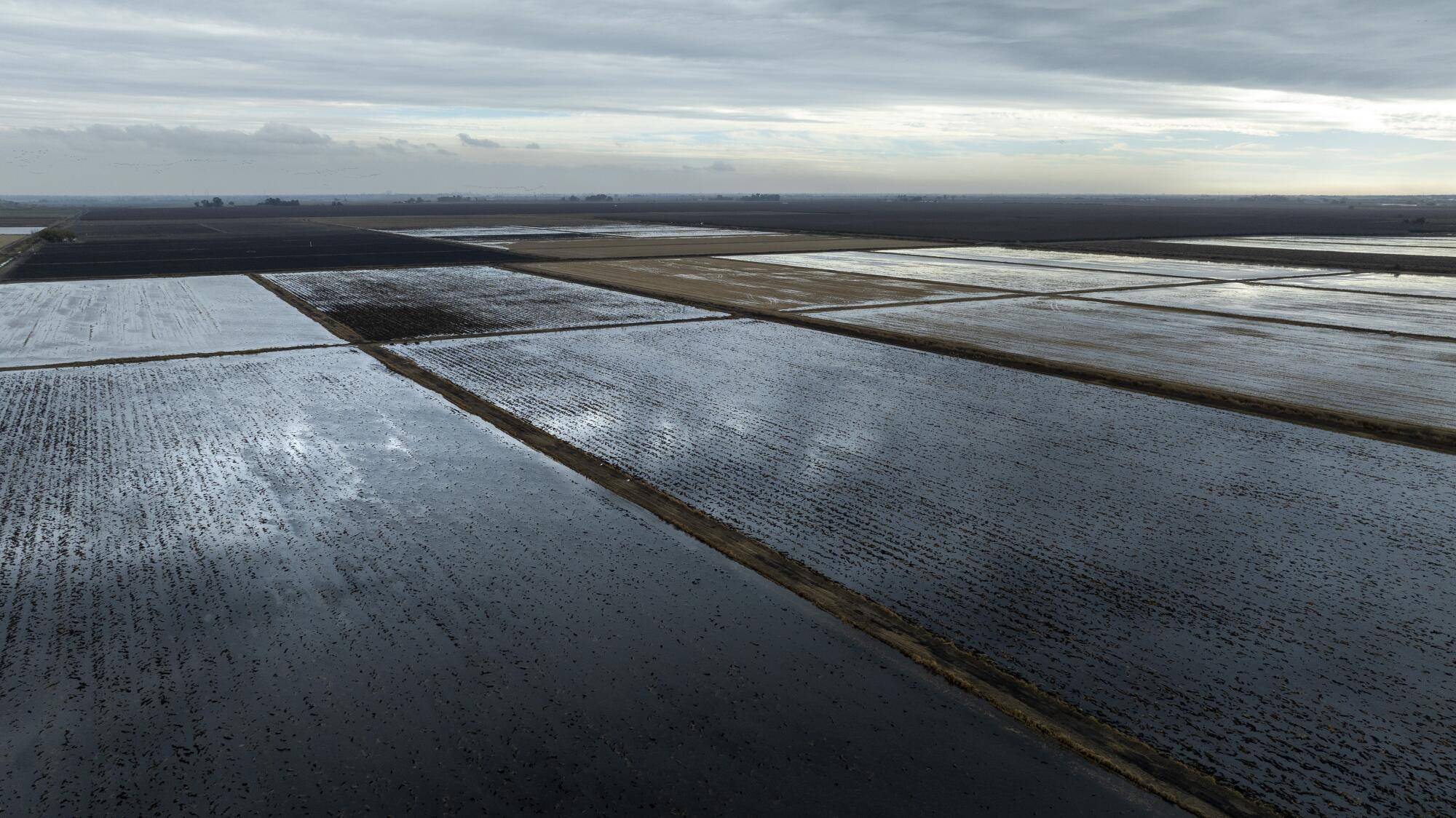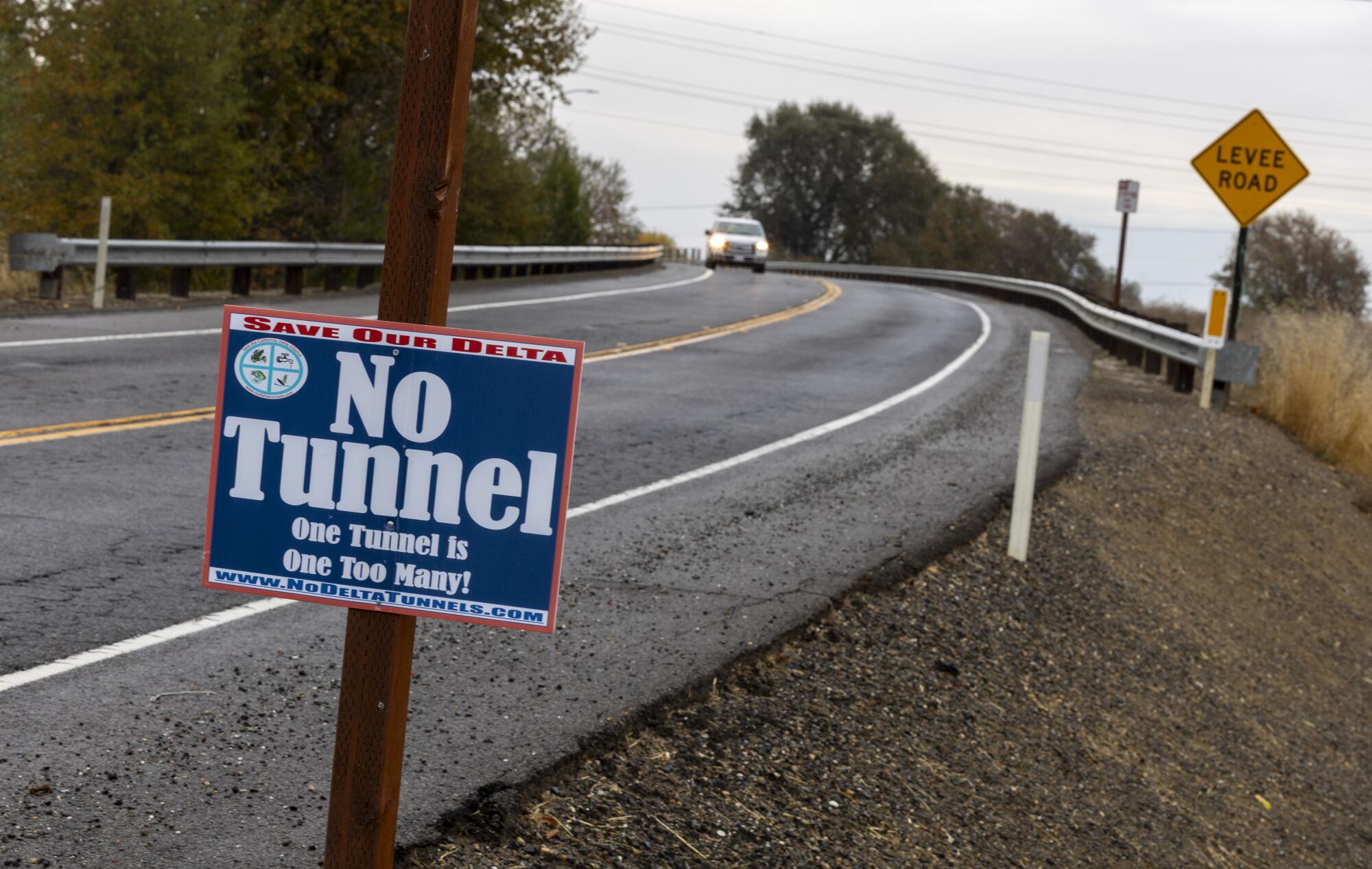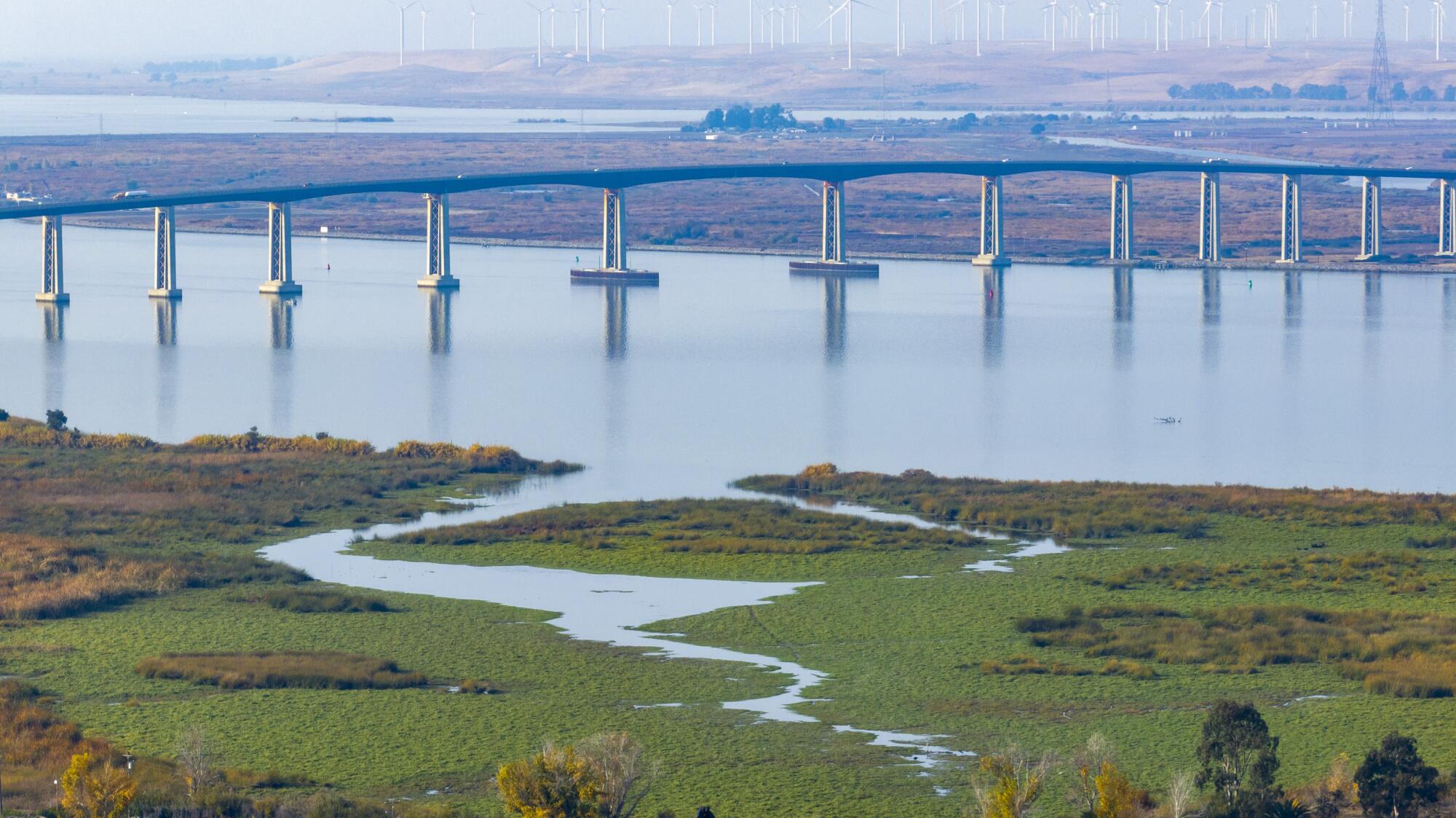Politics
Why border crossings fell after Trump-era rules expired

Fewer migrants are crossing the southern border of the U.S., and the doomsday scenarios that many politicians feared would follow the expiration of the pandemic-era restrictions known as Title 42 have yet to arrive.
The reasons for the decline in border crossings are still unclear — and the trend still in its infancy — but interviews with migrants offer some possible explanations.
Many U.S.-bound migrants, aware of the risks of entering the U.S. after the end of Title 42, including possible deportation and potential five-year bans from entering the United States, are playing a waiting game in Mexican border cities.
Cleven Ismael Peraza, a 26-year-old Venezuelan, is hoping to cross into the United States. Peraza, one of more than 3,000 migrants camped out along the Rio Grande in Matamoros, said he had previously been turned back after crossing while Title 42 was in place in May.
“We hear a lot of rumors — that there’s an endless line to get in, that some people are getting in, some people are being deported. We really don’t know exactly what is going on. Right now, seems best to wait,” he said Tuesday.
Migrants know “the rules are different now, and they can reject our applications for political asylum,” Peraza added.
Peraza said he will continue to try to use the problematic CBP One application and hope to score an appointment to the port of entry and seek asylum from there. The U.S. government has encouraged migrants to seek the appointments through the app, as opposed to crossing without authorization.
“Yes, we are scared. We had a dream to come here and start a new life. Now we are stuck here,” he added.
The Biden administration on Wednesday revealed that the downturn in border encounters had continued early this week: On Monday and Tuesday, border agents encountered fewer than 4,000 people at the southern border each day, according to Blas Nuñez-Neto, a lead Department of Homeland Security official. Since Friday, the first full day without Title 42, border agents have encountered an average of 4,400 migrants per day, he explained.
That’s a far cry from the more than 10,000 crossings per day early last week and many fewer than the Department of Homeland Security projections of 12,000 to 14,000 daily encounters after the end of Title 42.
Nuñez-Neto noted that regional governments, including Mexico’s and Guatemala’s, had deployed law enforcement and military personnel to police their southern borders. He said U.S. officials “continue to see encouraging signs that the measures we have put in place are working” but stressed that it was too soon to definitively predict what would happen next.
Migration experts and government officials who spoke with The Times agreed that it was too early to make any firm conclusions, but suggested several possible explanations for the decline.
“I think it’s a combination of two things. One, migrants seem to have gotten the message that policies post-Title 42 would be tougher than during Title 42, so rushed in before Thursday night,” said Julia Gelatt, a senior analyst at the Migration Policy Institute. “Second, there is a lot of confusion about what the policies are, and people may be waiting to see how other migrants fare before attempting their crossings.”
The Biden administration has worked hard to broadcast the idea that crossing the border without authorization can lead to serious consequences. A new Biden administration policy restricts asylum access for those who cross into the U.S. but have not applied for protections on their way to the border.
Department of Homeland Security Secretary Alejandro Mayorkas and other Biden administration officials have repeatedly said that the government would punish those who cross the southern border without permission.
“Do not believe the lies of smugglers,” Mayorkas said in a statement directed at migrants last week. “The border is not open. People who do not use available lawful pathways to enter the U.S. now face tougher consequences, including a minimum five-year ban on re-entry and potential criminal prosecution.”
In a tweet Tuesday, U.S. Customs and Border Protection’s Twitter account displayed an image of migrants being placed on a plane and buses.
“This weekend, Venezuelan migrants were transported by Mexican authorities to interior parts of Mexico from Reynosa. There are long-term consequences to entering the US w/out authorization under Title 8, including removal from the US, including bars to future immigration benefits,” the tweet read.
Nuñez-Neto told reporters Wednesday that Venezuelan, Cuban and Nicaraguan migrants were being turned back to Mexico.
Border officials had noticed a change, he said. Since Title 42 expired, roughly 1,000 migrants from Mexico, 510 from Colombia and 470 from Guatemala have tried to cross each day. In the days before the end of Title 42, roughly 2,400 migrants from Venezuela, 1,900 from Mexico and 1,400 from Colombia attempted crossings each day.
Caitlyn Yates, a fellow at the Strauss Center for International Security and Law who has been living in Tijuana for the last few months, said that her conversations with migrants in the area revealed that many were waiting in Mexico and trying to better understand the future of U.S. border policy.
Yates said that some migrants are waiting to see if they will get a slot using the CBP app. She added that many migrants, especially those from the Western Hemisphere, have heard the messaging about deportations and restrictions on asylum, along with the potential for a five-year ban on re-entry.
Yates said deterrence messaging had worked in the short term but that she did not know whether that will last. Migrants’ ability to secure appointments on the app will also affect whether they decide to cross, she added.
The administration has also advertised new legal avenues for migrants to enter the U.S. Those programs include one in which migrants from Cuba, Nicaragua, Venezuela and Haiti can apply to fly into the U.S. if they have a financial sponsor and can pass background checks.
The future of the administration’s policies, however, remains in limbo. The program allowing migrants to apply for legal entry into the U.S. is being challenged in a Texas federal court. The American Civil Liberties Union recently sued the Biden administration over its asylum restrictions, saying they were unlawful and resembled Trump-era policies.
Inside the government, however, officials have expressed some relief about the recent numbers, said one Department of Homeland Security official who spoke to The Times on the condition of anonymity because they were not authorized to speak publicly.
“There is certainly the view that our messaging is working,” said the official. “The deterrence message is working so we need to keep up the pressure to demonstrate that there are people being removed through this process,” the official said of the view internally. “People are worried that if there aren’t demonstrated consequences, the numbers will go back up.”
The official was cautious that the numbers would hold and said it was too early to tell the long-term effects of the policies.
U.S. government warnings have caused some migrants to take a guarded approach.
On the morning after Title 42 expired, Alexandre Jean Verneau had slept for the four previous nights along the border strip with El Paso, planning to give himself up.
But, with the end of Title 42, Verneau declined to turn himself in with hundreds of other migrants who had also been waiting for days in a strip of no-man’s land on U.S. territory along the Rio Grande. The 26-year-old Haitian feared it was a ”trick” and that he could end up being deported back to Haiti, he said.
Since then, Verneau has found work in construction in Ciudad Juárez. He says he plans to wait in the border city until he can secure an appointment via CBP One. Like so many others, he fears that entering illegally now could lead to deportation and other legal troubles.
“I’ve been trying and trying, day and night, but haven’t been able to upload the application,” Verneau said Tuesday. “I don’t have a date for an appointment yet. I don’t know when I’ll have one…. But I want to get out of here now. I want to go to the United States.”
He is renting a room in a house in Ciudad Juárez.
For now, Verneau plans to remain in Juárez until he can get an appointment.
Special correspondents Gabriela Minjares in Ciudad Juárez, Mexico, and Juan José Ramírez in Matamoros, Mexico, contributed to this report.

Politics
Alaska lawmakers end their session with late bills passing on energy, education

Alaska lawmakers ended their four-month session early Thursday with a flurry of last-minute bills addressing priority issues such as energy and correspondence school programs that are a focus of ongoing litigation.
Bickering over the budget was muted compared with prior years, and Republican Gov. Mike Dunleavy and legislative leaders claimed successes in a session that was not without drama, marked by twofailed attempts to override Dunleavy vetoes of additional public school funding.
ALASKA LAWMAKERS FAIL TO OVERRIDE OF GOV. DUNLEAVY’S VETO OF EDUCATION PACKAGE
EDUCATION
Education was billed as a top priority, and lawmakers in the bipartisan-led Senate and Republican-led House overwhelmingly passed a compromise package that included a permanent $175 million increase in aid to districts through a school funding formula. But Dunleavy, who had sought charter school provisions and a three-year teacher bonus experiment that divided lawmakers, vetoed the measure.
A veto override attempt failed, along with efforts in the House to cobble together another package. Ultimately, lawmakers settled for pieces including a one-time, $175 million boost to the foundation formula in the budget and additional funding intended to help K-3 students with reading.
Last year, Dunleavy vetoed half of a one-time, $175 million boost to schools but has signaled willingness to support the increase in the just-passed budget.
Sen. Löki Tobin, a Democrat who chairs the Senate Education Committee, said work remained to address issues facing public schools, which “are still going to be struggling” because the funding approved is inadequate. School officials and education advocates had pushed for a roughly $360 million permanent increase in funding.
Tom Klaameyer, president of NEA-Alaska, a teachers’ union, said the Legislature’s failure to reinstate a pension offering for public employees also was disheartening. A pension bill narrowly passed the Senate but stalled in the House. Senate leaders said work would continue around retirement issues.
Late in session, lawmakers pivoted to correspondence schools, which allow for students to be homeschooled under the authority of school districts. That focus came after a judge found that laws around correspondence school allotments “were drafted with the express purpose of allowing purchases of private educational services with the public correspondence student allotments.” Under the state constitution, public funds cannot be paid “for the direct benefit of any religious or other private educational institution.”
Lawmakers passed a bill with provisions aimed at providing stability for correspondence students while the litigation plays out.
“The idea was to be able to give some peace and calm to the people out there, the 22,000 students, who weren’t sure what was going to happen,” House Speaker Cathy Tilton, a Republican, told reporters early Thursday.
UNDERGROUND CARBON STORAGE
The second of two bills proposed by Dunleavy as a way to capitalize on interest by companies with carbon emission reduction goals passed, allowing the state to establish a system and protocols for underground storage of carbon dioxide, with an eye toward using pore space in aging gas or oil fields, such as Cook Inlet or on the North Slope.
Lawmakers last year passed Dunleavy’s bill allowing the state to set up carbon sequestration projects or to lease state lands to a third party wanting to develop a carbon project. Draft regulations for the offsets program were released in March.
Dunleavy previously pitched the bills as a novel means for Alaska to generate perhaps billions of dollars in new revenue while still embracing fossil fuel production and other resource extraction, such as timber harvests and coal production. But the revenue impact of the proposals remains speculative.
To pay for government, the state relies heavily on oil revenue and earnings from its nest-egg, an oil-wealth fund that has grown through investments. Lawmakers have been reluctant to raise taxes on industries, like oil, and Alaska, with about 737,000 residents, has no statewide sales or personal income taxes.
Rebecca Noblin is the policy justice director with the group Native Movement. In written testimony this month on the underground carbon storage bill, she said the measure “would allow oil and gas companies and coal plants to inject carbon from their operations back into the ground” and will “increase pollution, cost the state money and distract from real solutions to climate change.”
ENERGY
The carbon bill, HB50, also included a provision supporters said could encourage more gas production in Cook Inlet. So-called reserve-based lending would allow for the issuance of loans made against and secured by an oil and gas field, proven reserves or other assets of the borrower. Under the bill, loans could be made by the Alaska Industrial Development and Export Authority, a state corporation, for projects it deems necessary to bolster production.
Residents in Alaska’s most populous region rely on gas from the aging Cook Inlet basin. But gas availability has become a concern and was a focal point this session. In February, Luke Saugier, senior vice president for Hilcorp Alaska, told lawmakers that while the company is “not pulling back” on investments in Cook Inlet and is committed to developing its leases, gas under its lease holdings can’t meet all the region’s gas demand. He said other sources of energy are needed.
Sen. Bill Wielechowski, an Anchorage Democrat, said the lending provision could unlock gas fields and end up being “one of the most important things that we have done this year.”
Dunleavy’s office also applauded passage of a separate measure that it says would streamline tax and tariff policies “to make new and existing electrical generation projects more affordable.”
“That in turn incentivizes independent power producers to move forward on renewable power projects like solar and wind farms along the Railbelt,” his office said in a statement.
DIVIDEND
The size of the annual dividend paid to residents has often been one of the major points of contention, contributing to drawn-out or special sessions. But there was little pushback this year, with lawmakers agreeing to a dividend of roughly $1,360 and an energy relief payment of $295.
Legislative leaders pointed to better communication and a balancing of priorities, including what Republican Rep. DeLena Johnson, a House Finance co-chair, called a “solid” state infrastructure budget.
Politics
Newsom administration unveils new $20-billion cost estimate for delta water tunnel

Gov. Gavin Newsom’s administration announced that the estimated cost of building a tunnel to transport water beneath the Sacramento-San Joaquin River Delta has risen to $20.1 billion.
The estimate is part of a new cost-benefit analysis by the California Department of Water Resources, which concluded that the projected benefits of constructing the water tunnel would far outweigh the costs.
State officials released the analysis Thursday, saying the proposed Delta Conveyance Project is vital to improving the reliability of water supplies in the face of climate change, sea level rise and the risks of an earthquake that could put existing infrastructure out of commission for months.
The state estimates that the project’s benefits would total nearly $38 billion by offsetting steep reductions in water deliveries due to existing infrastructure limitations and climate change.
A gull flies above McLeod Lake in Stockton.
(Brian van der Brug/Los Angeles Times)
“The project easily passes a benefit-cost test,” said David Sunding, a UC Berkeley emeritus professor who led the analysis as a consultant for the state. “The benefits clearly justify the costs.”
The last time the state produced an estimate, in 2020, the price tag came to $16 billion. The cost increase, Sunding said, is almost entirely due to inflation. The projected benefits also increased.
The cost analysis is the state’s latest step toward building the 45-mile tunnel, which would create a second route to draw water from the Sacramento River into the aqueducts of the State Water Project.
Newsom says the project is critical for California’s future, but opponents argue it is a costly boondoggle that would harm the delta and further imperil its ecosystem.
Environmental groups, Indigenous tribes, fishing organizations and local agencies have filed lawsuits seeking to block the project.
This week, dozens of groups filed protests with the State Water Resources Control Board challenging a state petition to change its “point of diversion” in the delta — one of the steps necessary to move forward with construction.
The State Water Project supplies 27 million people and about 750,000 acres of farmland — fueling a $2.3-trillion portion of the state’s economy.

Flooded rice fields along the San Joaquin River in Stockton.
(Brian van der Brug/Los Angeles Times)
But state officials say the state’s existing pumping infrastructure in the south delta, which draws water into the California Aqueduct, is vulnerable to the more intense extremes driven by climate change, as well as sea level rise.

Aggressive and impactful reporting on climate change, the environment, health and science.
They estimate that if the state relies on its current infrastructure, there would likely be a 22% reduction in water deliveries by 2070. However, construction of the tunnel would boost supplies by an estimated 400,000 acre-feet annually, compared to the “no project” alternative.
The estimates included an analysis of impacts from sea level rise — using scenarios of a 1.8 feet or 3.5 feet rise by 2070 — which would bring increasing risks of delta levees failing or being overtopped, and higher salinity water encroaching on existing infrastructure.
State officials also analyzed the risk that a major earthquake would pose to the existing infrastructure, which they say could disrupt deliveries of supplies for months. Sunding said the tunnel would have a “superior ability” to withstand earthquakes and would make the state’s system less vulnerable.

A sign of opposition to the Delta Conveyance Project along a levee road near the Sacramento River in Hood.
(Brian van der Brug/Los Angeles Times)
“I get a lump in my throat when I look at the potential for a catastrophic failure in the delta,” said Karla Nemeth, director of the state Department of Water Resources. “This is a project that just provides enormous value to the broad California economy.”
Nemeth said the analysis shows that doing nothing would mean substantial costs for the state through frequent water shortages, mandatory restrictions in cities, and reductions in agricultural supplies that would force farmers to leave fields dry and fallow.
“It is vastly more efficient and economical to avoid declining supplies,” Nemeth said.
The costs of the project would be paid for by urban and agricultural water districts that decide to participate.
The state’s cost-benefit analysis is intended to provide information that local water agencies, such as the Metropolitan Water District of Southern California, will consider.

The Antioch Bridge over the San Joaquin River.
(Brian van der Brug/Los Angeles Times)
In preparing the updated cost estimate, the Delta Conveyance Design and Construction Authority examined potential “design and construction innovations” that could reduce the overall costs by about $1.2 billion.
Currently, about 56% of water deliveries from the State Water Project supply urban areas, while nearly 44% go to agriculture.
The analysis projects that with the tunnel, California would have fewer periods of mandatory water rationing and also less severe rationing, Sunding said. The project “helps to preserve the supplies that would otherwise be eroded through climate change,” he said.
State officials also compared the costs of additional supplies from the tunnel, at $1,325 per acre-foot, to the costs of additional supplies through investments in desalination, wastewater recycling, stormwater capture and conservation.
Sunding said they found the median costs of these other types of investments would be higher, with the exception of conservation, which is “in the same ballpark” with the project.
“But it is important to note that we’ve done a lot of water conservation in the state, particularly in Southern California and some parts of the Bay Area, and a lot of the cheapest water conservation projects have already been done,” Sunding said. “So there are limits to how much more water conservation there can be.”
However, other experts say California still has a great deal of potential to continue reducing water use through conservation. Researchers with the Pacific Institute, a water think tank, found in a 2022 study that the state could reduce water use by more than 30% in cities and suburbs by investing in measures to use water more efficiently.
Opponents of the tunnel project have argued the state should instead invest in other approaches in the delta, such as shoring up levees and restoring natural floodplains to reduce flood risks, while changing water management to protect the estuary’s health.

An angler casts into Bethany Reservoir in Byron.
(Brian van der Brug/Los Angeles Times)
Fish populations have suffered declines in recent years, and environmentalists say the tunnel would cause additional ecological harm.
State officials say the tunnel would lessen limitations on water deliveries linked to fish protections at the state’s existing pumping facilities in the south delta.
They point to this year as an example. Despite a wet winter and ample river flows, a rise in the deaths of steelhead trout and other fish in areas around the pumps forced reductions in pumping.
The Department of Water Resources said that if the delta tunnel had been in operation this year, an additional 909,000 acre-feet of water could have been delivered from intakes in the north delta, helping to resolve what officials described as “difficult conflicts” in the south delta.
“The status quo is not an option going forward. It’s just not something that can be maintained,” Sunding said. “One way or another, the system is going to change. Climate change is going to have its impact.”
Politics
Illegal immigrants from foreign adversary hit new high amid national security fears: 'Extremely alarming'

A record-breaking number of Chinese nationals have illegally crossed the border nationwide so far this fiscal year, figures released this week show, an increase of nearly 8,000% since FY 2021.
Customs and Border Protection updated its encounter numbers for April, showing that now there have been 27,583 encounters of Chinese nationals by Border Patrol this fiscal year, which began in October.
That is compared to 24,125 in all of FY 2023, 1,987 in FY 2022 and just 342 in FY 2021.
ILLEGAL MIGRANTS FROM THIS FOREIGN ADVERSARY ARE INCREASINGLY CROSSING THE BORDER
Migrants in line in Jacumba, California. Border authorities are contending with an influx of Chinese migrants in a key border sector. (Robert Gauthier/Los Angeles Times via Getty Images)
This means there has been a 7,965% increase from FY 2021 in numbers of Chinese crossing illegally. Of the 27,583 so far this FY 2024, 23,622, or 85%, were single adults.
More than 90% of the crossings this FY 2024 have been in the San Diego sector. There have also been more than 1,200 encounters in the first eight days of May, an average of more than 150 a day.
Republicans and some border officials have raised concerns about the potential for espionage, as well as the smuggling of drugs like fentanyl. Republicans on a House Homeland Security subcommittee are holding a hearing Thursday on the matter, called, “Security Risk: The unprecedented surge in Chinese illegal immigration.”
Democrats dismissed that hearing, calling it on their website, “Another Republican border ‘hearing’ with invasion rhetoric and fearmongering.”
SOUTHERN BORDER MIGRANT ENCOUNTERS DECREASE SLIGHTLY BUT GOTAWAYS STILL SURGE UNDER BIDEN

A Chinese migrant speaks to a border patrol officer before being processed after crossing the Rio Grande into the U.S. (Brandon Bell)
A committee spokesperson told Fox News Digital this week that the minority expects Republicans to use the hearing to “employ hyperbolic and xenophobic rhetoric to scaremonger about a ‘foreign invasion’ at the border.”
“But the facts show that changes to Chinese migration reflect deteriorating economic and political conditions in China, and broader shifts in global migration patterns,” they said. “Responding to those shifts requires congressional action, including bipartisan legislation and additional funding for border security – which Republicans consistently oppose or block.”
Republicans on the committee described the dismissiveness as “disappointing.”
“It’s sad that House Democrats’ response to this hearing sounds more like Chinese state media than anything else,” Subcommittee on Oversight, Investigations, and Accountability Chairman Dan Bishop told Fox News Digital.
“This fiscal year, apprehensions of Chinese nationals by Border Patrol agents at our Southwest border already exceed those from fiscal years 2007 – 2020 combined,” he said. “It should be extremely alarming to everyone, regardless of party, when record numbers of individuals from an adversarial nation flood into our country without vetting or oversight. House Democrats are clearly uninterested in combating this national security threat, which is disappointing — but not surprising.”
Overall, the numbers of migrant encounters in April declined slightly. There were 179,725 encounters across the southern border in April, compared to 211,992 in April 2023 and 189,357 in March.
-

 Politics1 week ago
Politics1 week agoBiden takes role as bystander on border and campus protests, surrenders the bully pulpit
-

 Politics1 week ago
Politics1 week ago'You need to stop': Gov. Noem lashes out during heated interview over book anecdote about killing dog
-

 Politics1 week ago
Politics1 week agoRFK Jr said a worm ate part of his brain and died in his head
-

 News1 week ago
News1 week agoMan, 75, confesses to killing wife in hospital because he couldn’t afford her care, court documents say
-

 World1 week ago
World1 week agoPentagon chief confirms US pause on weapons shipment to Israel
-

 Politics1 week ago
Politics1 week agoHere's what GOP rebels want from Johnson amid threats to oust him from speakership
-

 World1 week ago
World1 week agoPro-Palestine protests: How some universities reached deals with students
-

 World1 week ago
World1 week agoConvicted MEP's expense claims must be published: EU court













